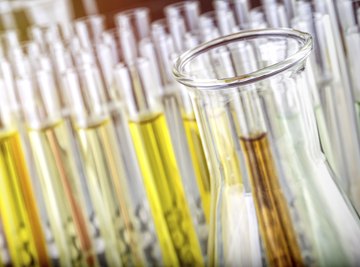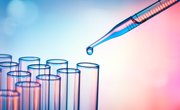
When you mix two substances, sometimes a chemical reaction takes place that results in a change of color, state or temperature. Mixing solid lead nitrate and solid potassium iodide results in a change of state. A cloudy yellow precipitate – an insoluble solid that comes from a liquid solution – forms.
TL;DR (Too Long; Didn't Read)
When you add lead nitrate to potassium iodide, their particles combine and create two new compounds, a yellow solid called lead iodide and a white solid called potassium nitrate. Yellow clouds indicate that the chemical change has taken place.
Mixing Chemicals Together
When you mix two chemicals, their particles may combine and make two new compounds. When you combine lead nitrate and potassium iodide solutions, a double-replacement reaction happens. The two compounds react, and the positive ions and negative ions of the two reactants switch places, creating two new compounds.
Lead Nitrate and Potassium Iodide
The lead nitrate solution contains particles (ions) of lead, and the potassium iodide solution contains particles of iodide. When the solutions mix, the lead particles and iodide particles combine and create two new compounds, a yellow solid called lead iodide and a white solid called potassium nitrate.
Doing the Experiment
You can use solutions of lead nitrate and potassium iodide or mix them as dry powders to create the chemical reaction.
To use solutions, pour the same amount of each powder into a test tube and add water to encourage the movement of molecules and ions.
Pour the lead nitrate solution into the test tube with the potassium iodide solution to form lead iodide, which looks like yellow clouds. The clouds are made up of tiny solid particles suspended in the solution. Potassium nitrate forms too, but it is white and disguised by the yellow lead iodide.
If you heat the solution, the lead nitrate dissolves completely. When it cools, it slowly crystallizes, creating large crystals.
To mix the compounds dry, pour both powders into one test tube, cover the opening with a finger, and shake the test tube vigorously. Typically, only liquids and gases have chemical reactions because their molecules are looser and can move around freely and collide with one another. The molecules in solids are tightly packed together, so they don’t have the freedom to move around and collide.
The shaking movement in this experiment makes the surface of the crystals collide with one another, starting a chemical reaction that creates a yellow powder, which is a combination of lead iodide and potassium nitrate.
References
About the Author
Claire is a writer and editor with 18 years' experience. She writes about science and health for a range of digital publications, including Reader's Digest, HealthCentral, Vice and Zocdoc.
